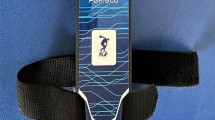Abstract
The purpose of this study was to compare three types of objective measurement in Lachman test position and to validate a new measurement procedure. Twenty-three patients were evaluated after anterior cruciate ligament (ACL) reconstruction at 10 years’ mean follow-up. The contralateral knee had a normal ACL. Both knees were compared using Lachman test, arthrometer, radiological drawer, and electromagnetic sensing device (EMS) measurements. The values were obtained by two trained orthopaedic surgeons independently. Arthrometer assessment was done with the Kneelax 3 (Biodex) at 88 and 132 N. Radiological drawer was measured with a load of 10 kg. EMS is composed of an electromagnetic transmitter and two sensors. Displacement of the sensors was measured along the three perpendicular axes of the transmitter. Data after processing give the displacement of the sensors perpendicular to the tibial axis. The load was applied on the calf perpendicular to the tibial axis with a 10-kg counterweight. Metallic objects must be avoided around the set-up. No significant difference between examiners was observed in clinical (P = 0.45) or objective (P > 0.3) measurements. The best correlation was obtained between arthrometer and EMS measurements (R = 0.94). Arthrometric and radiological drawer were poorly correlated (R = 0.65). The values of the medial radiological drawer were quantitatively similar to the 132 N arthrometric values. The sensitivity of EMS to skin movements was tested. The correlation between the EMS drawer and the other movements was not significant (R≤ 0.37). Quantitative correspondence with Lachman grades was only 36% of the arthrometer and EMS values and 37% of the radiological measurements. The effectiveness of EMS to evaluate anterior tibial displacement in Lachman test position after ACL reconstruction is demonstrated in this study. This method is non-invasive and comfortable for the patient, but needs a careful set-up. This method can potentially be used to assess rotational laxities.
Similar content being viewed by others
Author information
Authors and Affiliations
Additional information
Received: 15 November 1996 Accepted: 2 December 1997
Rights and permissions
About this article
Cite this article
Benvenuti, JF., Vallotton, J., Meystre, JL. et al. Objective assessment of the anterior tibial translation in Lachman test position Comparison between three types of measurement. Knee Surgery 6, 215–219 (1998). https://doi.org/10.1007/s001670050102
Issue Date:
DOI: https://doi.org/10.1007/s001670050102




